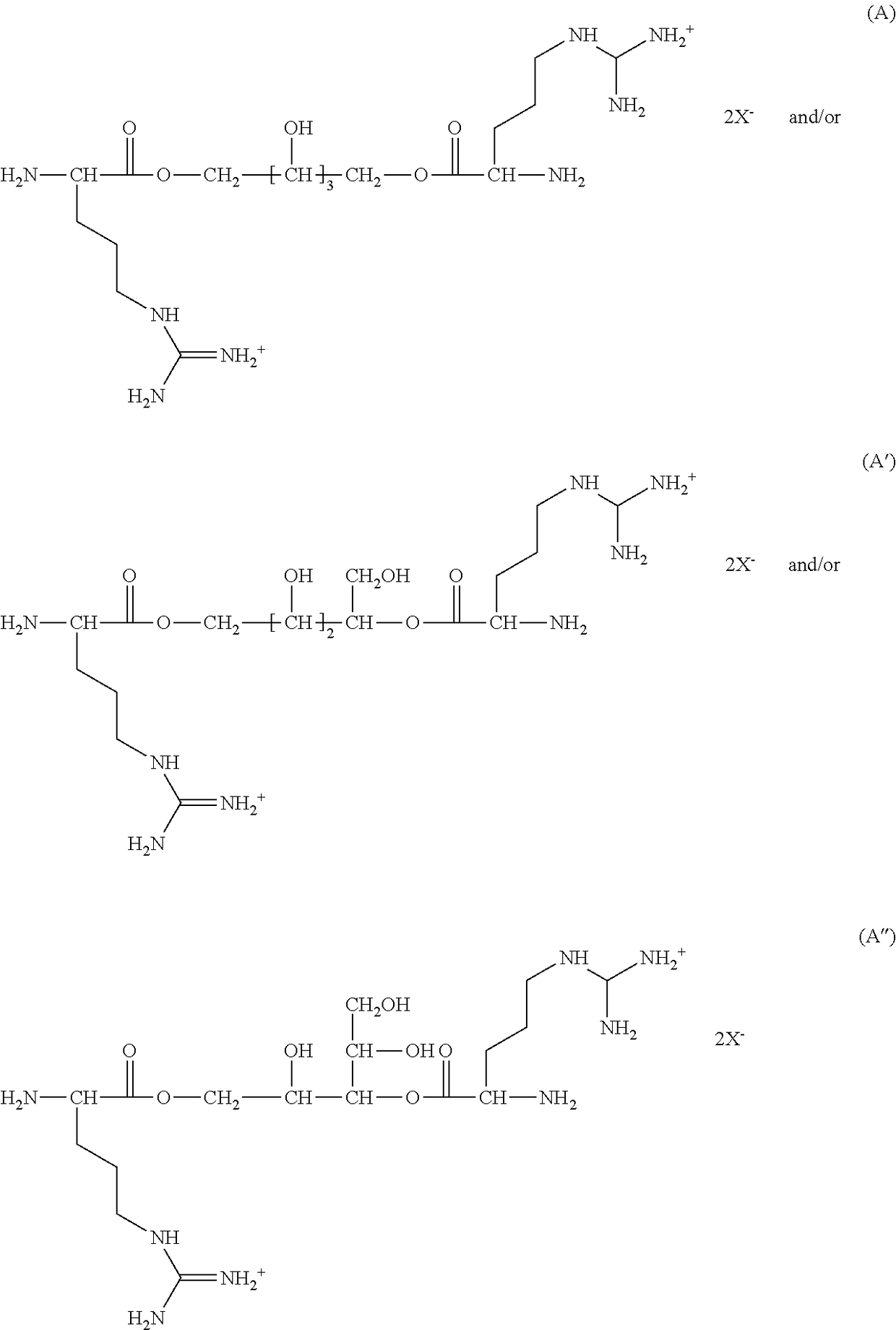Oral care compositions
a technology of oral care and compositions, applied in the field of oral care compositions, can solve the problems of plaque accumulation, dental calculus, plaque adhesion to dental surfaces, etc., and achieve the effect of preventing acid production
- Summary
- Abstract
- Description
- Claims
- Application Information
AI Technical Summary
Benefits of technology
Problems solved by technology
Method used
Image
Examples
example 1
Experimental Procedure for the Preparation of Bis(p-Nitrophenyl) Succinate.
[0135]In a 1 L 3-neck flask, equipped with an overhead stirrer, addition funnel and thermometer, is dissolved 40.0 g (0.288 mole) of p-nitrophenol in 500 mL of acetone under a nitrogen atmosphere. To the resultant bright yellow solution is added 29.1 g (0.288 mole) of triethylamine. The resultant yellow solution is cooled to 5° C. and a solution of 21.2 g of succinoyl dichloride in 100 mL of acetone is added dropwise over a 1.5 hr period, an exotherm is noted during the addition. Upon completion of the addition the brown-red suspension is stirred at 5° C. for an additional hour and then allowed to warm to ambient temperature and stirred overnight. The resultant brown-purple suspension is added 1 g of succinoyl dichloride and stirred an additional 30 minutes at ambient temperature. Added 500 mL of deionized water and stirred at ambient temperature for 15 minutes. The product is isolated by filtration and the s...
example 2
Experimental Procedure for the Preparation of Bis(L-Arginine) Xylitol Diester
[0136]In a 2 L 4-neck flask, equipped with a Dean-stark trap, an overhead stirrer and thermometer, is added 17.4 g (0.1 mole) of L-arginine, 7.6 g (0.05 mole) of xylitol, 40 g (0.21 mole) of p-toluenesulfonic acid monohydrate and 1 L toluene under an argon atmosphere. The resultant mixture—is heated at 110° C. for 16 hr and 5.5 mL of water—is collected. Upon cooling the reaction mixture a yellow oil separated and the toluene layer—is decanted. The yellow oil is dissolved in isopropanol at 70° C., cooled to 4° C., and decanted isopropanol. The isopropanol treatment—is repeated 2 additional times. The product is dried on a rotary evaporator to give 50 g of a white powder.
example 3
Experimental Procedure for the Preparation of Arginine-Xylitol-Succinic Acid Polymer
[0137]In a 50 ml round bottom flask is added 14 g (12.2 mmole) of tetra-p-toluenesulfonic acid salt of bis(L-arginine) xylitol diester, 4.4 g (12.2 mmole) bis(p-nitrophenyl) succinate and 14 g of dimethylsulfoxide under a nitrogen atmosphere. The mixture is mixed on a vortex mixer to form a brown solution and then heated at 75° C. To the resultant reaction mixture is added dropwise 2.7 g (26.8 mmole) of triethylamine. The resultant yellow solution is heated at 75° C. for 48 hr under nitrogen then cooled to ambient temperature. To the resultant reaction mixture is added 3 mL of ethyl acetate, stirred, and the supernatant decanted. Dissolved polymer in methanol, precipitated into ethyl acetate and decanted supernatant. The methanol / ethyl acetate precipitation procedure is repeated 2 additional times and the product is dried on a rotary evaporator to obtain 7.4 g of a yellow-brown powder. The polymer is...
PUM
| Property | Measurement | Unit |
|---|---|---|
| total weight | aaaaa | aaaaa |
| weight | aaaaa | aaaaa |
| mass | aaaaa | aaaaa |
Abstract
Description
Claims
Application Information
 Login to View More
Login to View More - R&D
- Intellectual Property
- Life Sciences
- Materials
- Tech Scout
- Unparalleled Data Quality
- Higher Quality Content
- 60% Fewer Hallucinations
Browse by: Latest US Patents, China's latest patents, Technical Efficacy Thesaurus, Application Domain, Technology Topic, Popular Technical Reports.
© 2025 PatSnap. All rights reserved.Legal|Privacy policy|Modern Slavery Act Transparency Statement|Sitemap|About US| Contact US: help@patsnap.com



